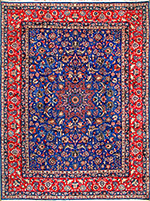Textiles Studies

Textile Research Works
Geometry Made Manifest: Reorienting the Historiography of Ornament on the Iranian Plateau and Beyond
Date of this Version
2017
Document Type
Article
Citation
The Historiography of Persian Architecture (2017), Edited By Mohammad Gharipour, pp. 41-79.
doi:10.4324/9781315690476
Abstract
From Owen Jones' Grammar of Ornament compiled in the middle of the nineteenth century to the discovery of quasicrystals in the late twentieth century and Lu and Steinhardt's and others' explorations of decagonal and quasiperiodic tilings in Islamic monuments of Iran, the interpretation of ornament in Islamic architecture and the arts has undergone profound reassessment during the past 150 years.' Broad-ranging questions concerning the universality of geometry that Oleg Grabar raised in his Mediation of Ornament and the probing studies of Alpay Ozdural in the 1990s on architectural ornament, as well as Gulru Necipoglu's historical exposition of The Topkapt Scroll, have contributed to a shift from assuming that ornament is ornamental to questioning and considering the underlying mathematical nature of ornament as well as the cultural specificity of its uses in Islamic art.2 In Iran, Afghanistan, and Central Asia during the eleventh and twelfth centuries, the brick decoration of numerous architectural monuments dramatically expanded the repertory of geometric ornament. Among many monuments on the Iranian plateau, four tomb towers exemplify this new geometric style, characterized by patterns in the plane (illustrated in Figures 3.1-3.3); coincidentally, these four monuments also document the introduction and increasing use of glazed ceramics to highlight and articulate particular aspects of ornament (Figure 3.2). Mounting evidence and arguments suggest that these and other monuments with their exuberant geometric ornament reflect contemporary cultural values and represent points of intersection in the histories of architecture and mathematics. Contributing to a heuristic and discursive methodology to approach interpretations of meaning, case studies of these four monuments can serve as focal points to reorient the historiography of ornament in Islamic art of Iran and neighboring regions during a formative period in the eleventh and twelfth centuries.


Comments
Link to book publisher page. Copyright © 2017 Routledge / Informa UK Limited, an Informa Plc company